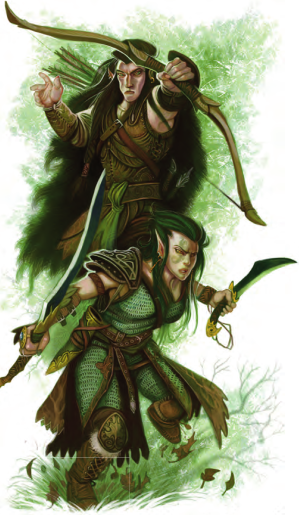Let's Read the 4e Monster Manual/Vault: Elf

This article is part of a series! Click here to see the other entries.
I’ve mentioned elves plenty of times already, and now it’s time to talk about them properly. They’ve been available as a playable character option since the days of Basic (though arguably Basic elves were closer to eladrin).
This entry is for the elves you might meet as enemies or NPC allies. They’re present in both the MM and the MV.
The Lore
We’ve already looked at drow and eladrin, so we know that 4e elves are an offshoot of an ancient fey people created by Corellon who migrated from the Feywild to the world and went through some adaptative changes over the generations.
They look pretty much like what you’d expect a D&D elf to look: slender, sharp features, pointy ears. They’re about as tall as humans, perhaps a tiny bit shorter. Their hair has “earthier” colors than those of eladrin, with several shades of brown being the most common along with tones like moss-green, autumn orange, and so on. Their eyes can be brown, green, blue or violet, and have a more familiar “sclera and iris” arrangement than the solid orbs of color found in eladrin. Elf skin tones are the same as those found in humans, with the darker tones being more common.
Elves primarily worship Melora and the primal spirits, so their relationship with nature is more reverent and has a greater conservationist bent than that of eladrin. Eladrin alter a forest with magic so that it grows harmoniously around and within their shining cities; elves prefer to adapt their own lifestyle and settlements to fit the existing natural landscape, which is how you get treetop villages.
To a human elves usually seem laid-back and flighty, as their lifespans are still large enough that they take a long view of most things. Still, they’re less aloof and disinterested than the eladrin, since they do live in the world and care about what happens here.
The Numbers
We have four elf stat blocks here, two of which are exclusive to the MM and all of which are early-Heroic. Elves are Medium Fey Humanoids with the same signature traits they get as PCs:
- Low-light vision
- Speed 7.
- Wild Step, which lets them ignore difficult terrain when shifting.
- Elven Accuracy, which lets them re-roll an attack once per encounter.
The MM versions also get Group Awareness, which gives +1 to the Perception tests of all allies within 5 squares. This is absent from the MV, as it’s more relevant to PCs than to monsters.
Elf Archer
Can’t get more typical than this! Present in both books, the archer is Level 2 Artillery with 32 HP and all common elf traits. It also gets Archer’s Mobility, gaining a +2 bonus to attacks in turns where it moves 4+ squares.
It wields a longbow and has a shortsword for emergencies, neither of which is affected by the damage bug. It also has a triggered ability called Not So Close, which allows it to shift 1 square and make a ranged attack against an enemy that makes a melee attack agains it. This is a reaction, so the enemy attack has to be resolved before the elf can get away.
Crossbowdwarves fight in close formation; eladrin bow mages spread out a bit more; elven archers are tree-hopping ninjas that never stay still.
Elf Scout
Okay, you can get more typical than that. The Elf Scout took the two-weapon path instead of going with archery. As such, it’s a Level 2 Skirmisher with 39 HP and all common elf traits. It’s present in both books.
It wields a longsword in one hand and a shortsword in the other, each counting as a basic attack. It can attack with both in one action using Two-Weapon Rend, dealing a bit of extra damage if it hits with both blades. It also sneak attacks for 1d6 extra damage. Yes, the two effects can stack.
No special mobility powers other than the common traits, which already make the scout pretty mobile.
Elf Hunter
A Level 2 Minion Skirmisher, the elf hunter is likely a literal hunter that has to defend themselves in a pinch. It lacks Elven Accuracy but has all other common traits. It fights with a shortsword, and its basic attack allows it to shift 2 squares on a hit or 1 on a miss.
Elf Noble Guard
Wearing mail and wielding a longsword, the noble guard is a Level 3 Soldier with 46 HP and all common elf traits. It retains its Speed 7 even in mail. As expected of a soldier, the longsword attack marks for a turn. It can also use a Hobbling Strike which does more damage and immobilizes for a turn on a hit. On a miss it does half damage and slows instead. This also counts as a basic attack, so it can be used in charges and the like, but it recharges on 5-6 so the simpler longsword blow will still see plenty of use.
If someone ignores the noble guard’s mark, it can attack that enemy as a reaction, dealing standard longsword damage and immobilizing the target on a hit.
Sample Encounter and Final Impressions
There’s one sample encounter in the MM: Level 2, two archers, two scouts, and two grey wolves. A typical war party made up of typical members.
These stat blocks do a good job of conveying that wood elf flavor. In most campaigns I think it’s more likely that the PCs will end up having some of them as NPC allies than as enemies, just as with dwarves. Still, plenty of campaigns are likely to have at least one enclave of paranoid forest guardians who shoot strangers on sight.
A little rejiggering of signature traits and the addition of spiders can also turn the sample encounter into a party of drow scouts for some early-Heroic foreshadowing of Underdark shenanigans.